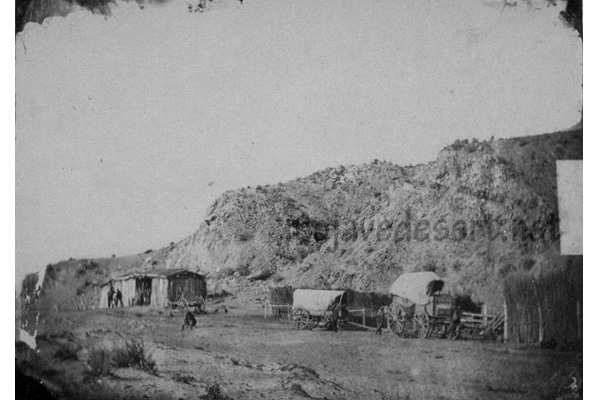Sagebrush Annie
& the Sagebrush Route
By Richard & Kathy Thompson
This is the story of a nine-mile stretch of Route 66 on the Mojave Desert between Oro Grande and Helendale, featuring Sagebrush Annie, owner of the Sage Brush Inn. The story primarily covers the time period of 1925 to the mid-1940s. These were the years of Prohibition, the Depression and World War II; from hard-scrabbling years of great poverty to the beginnings of prosperity.
Before the road became Route 66 it was called National Old Trails Highway, which was very primitive until it was straightened and leveled in 1925 and paved the following year. The year 1945 was the end of World War II, and in that year county officials established the first building ordinance for the desert, changing the local architecture considerably. This story tells about the conditions of the road from just before its construction, and of the founding of the little businesses built along it to accommodate travelers.
The stretch of highway begins at the railroad underpass just north of the center of Oro Grande (that community is left aside because it is a story in itself). When publishing stories on this segment of the road in the 1940s, the Victor Press headed the column, "Along the Sagebrush Route."

Point of Rocks - 1863
The route extends to the vicinity of Helendale, and "vicinity" is used because there is no Helendale--no town, that is. The community started existence as a watering stop for the steam-driven railroad. It was called Point of Rocks in early days, but later renamed Helen, after a railroad official's daughter, before ultimately becoming Helendale. A little store was built nearby, and the store and railroad buildings comprised Helendale. When the railroad, for various reasons, no longer needed the station, the buildings were removed. That left the little store, and as it moved around, the "town" of Helendale moved with it.
The situation was much the same decades later when the town consisted of a store/service station and the U. S. Post Office. Sarah Orebaugh, Postmaster at the time, tells of a man who came into the Post Office and wanted to know where Helendale was. When told he was in it, the fellow reddened, pounded the table and said, "Now, are you going to tell me where Helendale is, or not?" Mrs. Orebaugh responded, "Yes, sir, I am. I don't know what more you could ask for. You're standing right in the middle of the federal building, next door is the grocery store, pool hall, the bar, the service station and all of that." Such was the town of Helendale.
The era of the horse ended by 1925, and just two decades later heavy traffic was zooming along the highway. In the late 1940s Las Vegas became popular, and the nature of travelers changed. Celebrities, gamblers and fun-seekers added to the traffic on the road. The popularity of Las Vegas skyrocketed, and stars like Frank Sinatra, Dean Martin, Sammy Davis, Jr. and the rat pack were on the highway along with their entourages, headed to the Sands and other watering holes, followed by thousands of fans ready for a weekend's entertainment. Local citizens on our little segment of the highway needed all their wits about them to get in and out of their driveways as the caravans came barreling through.
All of this came to an end, at least for our highway, when the freeway to Barstow opened December 13, 1958. Oro Grande and Helendale growth came to a halt, and, excepting the Silver Lakes development in the 1970s, not much has changed to this day. Some of the little businesses quickly closed, and some sputtered along for a while. Eventually they all closed, but many buildings are still there, some occupied by residents or new businesses.
The history begins with how the road came to be, followed by a section on Prohibition. Driving through the area one can envision blind pigs (a name for places illegally selling liquor) and the moonshiners and their stills hidden off in distant canyons.
Next is the tale of Sagebrush Annie, the most colorful character on the road, and perhaps the most successful business person in her time and place. Her humble building served as a residence, service station, cafe, bar, dance club, and according to some accounts, a brothel. By the late 1930s Sagebrush Annie's had the reputation, well earned it appears, of being a wide-open honky-tonk, and the ladies of the society pages stopped writing about it in their newspaper columns.
Finally, there is a self-guided tour with the businesses, or their remains, identified along the way.
Next >
Two Ruts in the Sand
The Needles Road
Chief Bootlegger & Builder
Sagebrush Annie
Roadhouse
Sage Brush Route Tour

Sagebrush Inn 1972
Featuring Route 66
.jpg)
It doesn't represent America, it is America!